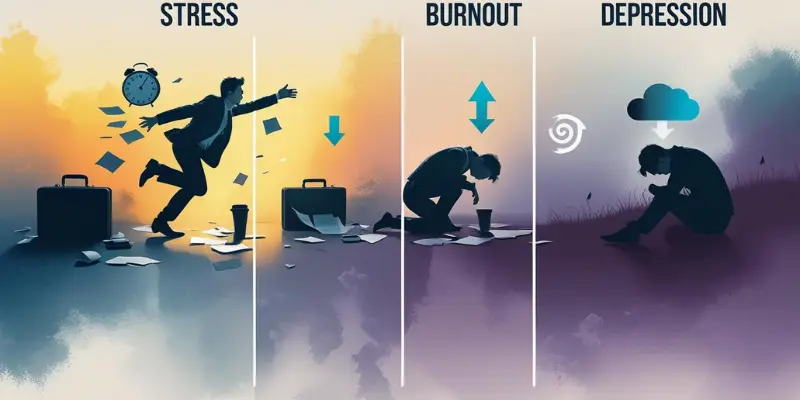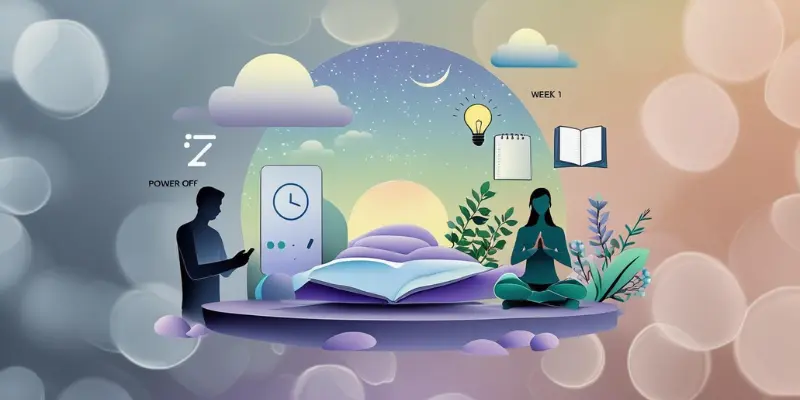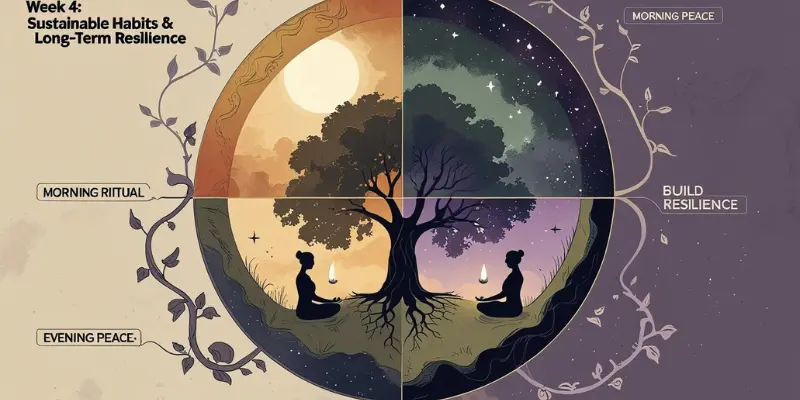Burnout Recovery 101: A Practical 4-Week Plan to Reclaim Your Energy
Published: 02/08/2025
Feeling completely drained, cynical, and just “over it”? If you find yourself constantly exhausted, struggling to find motivation, and feeling disconnected from what once brought you joy—chances are you’re facing burnout. And you’re not alone. In fact, burnout is becoming an epidemic. A recent study showed that more than 60% of professionals report feeling burned out, especially in the wake of the pandemic. Younger generations, like Millennials and Gen Z, are particularly vulnerable, juggling high expectations, intense workloads, and the pressure to “do it all.”
Remember when you loved your work or passion? That project you once threw yourself into now feels like a never-ending to-do list. You may have once felt excited by your career or hobbies, but now it’s hard to summon any enthusiasm. You’re not just tired; you’re worn out.
But here’s the good news: This isn’t the end of the road. Burnout doesn’t have to define you. It’s not an inevitable part of the grind, and it’s absolutely possible to regain your energy, clarity, and passion.
This isn’t just another article on symptoms. This is a practical, step-by-step, 4-week roadmap designed to help you reclaim your energy, sharpen your focus, and rediscover your vitality. This plan is realistic, structured, and most importantly—it’s achievable. You won’t have to quit your job, take a year off, or make radical changes. Instead, you’ll build sustainable habits that fit into your daily life, no matter how busy you are.
| What will you learn? |
|---|
Over the next four weeks, we’ll focus on specific, actionable strategies that will move you from feeling depleted and overwhelmed to empowered and recharged. Each week, we’ll tackle a different aspect of burnout recovery, helping you take control of your life and wellness—one step at a time. |
Ready to start? Let’s dive into the first week of your recovery journey.
Understanding Burnout: Beyond Just Being Tired
Burnout is not just about being tired. It’s a state of emotional, physical, and mental exhaustion caused by prolonged stress and overwork. According to the World Health Organization (WHO), burnout is officially recognized as an “occupational phenomenon,” meaning it arises specifically from work-related stress. This isn’t about a bad day or a tough week; burnout builds up over time, usually when individuals feel overwhelmed, underappreciated, or unable to meet constant demands at work or in personal life.
Burnout affects your ability to perform, think clearly, and engage with the world around you. It’s a combination of deep exhaustion, a sense of helplessness, and a disconnection from what you once cared about. It’s not something you can push through, and it’s more than just “feeling tired”—it’s a complete drain on your energy, emotions, and capacity.
Burnout vs. Stress vs. Depression: Knowing the Differences
While burnout, stress, and depression may seem similar, understanding the differences is crucial for effective recovery. Here’s how they differ:
- Stress is a natural response to pressure. It can motivate us to get things done and is often short-term. However, when stress becomes chronic or overwhelming, it can lead to burnout.
- Burnout is a prolonged state of emotional, physical, and mental exhaustion. Unlike stress, which may come and go, burnout tends to feel more persistent and demoralizing. You might feel like you’ve given all you have and still can’t keep up.
- Depression goes beyond burnout, impacting your overall mood and outlook on life. It often includes feelings of sadness, hopelessness, and a lack of interest in daily activities. Burnout can sometimes evolve into depression if not addressed.

Why does this matter for recovery? The solutions for burnout are different from those for stress or depression. Understanding what you’re dealing with allows you to take the right steps toward recovery and avoid unnecessary frustration. For example, while stress can often be alleviated through short-term relaxation techniques, burnout requires deeper, long-term lifestyle changes. Depression, on the other hand, may need professional treatment, such as therapy or medication.
When to seek professional help: If you suspect your burnout is turning into depression, or if you’re unable to manage your symptoms on your own, it’s important to seek professional help. A counselor, therapist, or doctor can help guide your recovery, whether it’s through therapy, medications, or additional support resources. Don’t hesitate to reach out for help when needed.
Common Signs You Might Be Burned Out
It’s easy to ignore the early signs of burnout, especially when life feels overwhelming. But recognizing the warning signs early on is key to stopping burnout before it completely takes over. Here are some common red flags to look out for:
Physical Red Flags: Persistent Exhaustion, Aches, Frequent Sickness
- Exhaustion: You feel drained, no matter how much you rest or sleep. Your energy levels feel like they’ve hit rock bottom, and it’s hard to get through the day without feeling completely wiped out.
- Aches and Pains: Unexplained muscle aches, headaches, or stomach problems can be physical signs of burnout. Your body may start showing symptoms of stress it can’t handle.
- Frequent Illness: When your body is under constant stress, your immune system weakens. You may find yourself getting sick more often than usual, with colds, headaches, or stomach issues becoming a regular occurrence.
Emotional Warning Signs: Cynicism, Detachment, Lack of Motivation
- Cynicism: You begin to feel disconnected from the work or people you once enjoyed. Tasks seem pointless, and you may start feeling frustrated or resentful toward your job or personal responsibilities.
- Detachment: Burnout makes you feel emotionally drained, leading to feelings of detachment. You might find it hard to care about things you once did or withdraw from activities and relationships that once gave you joy.
- Lack of Motivation: Even simple tasks feel like massive mountains to climb. You’re no longer driven or inspired to achieve anything, and even small goals seem overwhelming.
Behavioral Cues: Withdrawal, Procrastination, Increased Irritability
- Withdrawal: You begin withdrawing from social interactions and avoiding work, often choosing isolation. This can lead to feelings of loneliness and a growing sense of disconnection.
- Procrastination: Burnout can make it hard to get things done. You might procrastinate or avoid completing tasks because you feel overwhelmed or uninterested.
- Increased Irritability: When you’re burned out, little things may set you off. You become easily irritated by colleagues, family members, or everyday situations. It’s as if you’re running on empty and can’t handle any more stress.
Expert Tip: One of the most important indicators of burnout is “emotional overload.” Even if you don’t notice physical or behavioral signs, if you’re feeling emotionally drained and overwhelmed, it could be a strong signal that you’re burned out.
Unpacking the Root Causes of Your Burnout
Understanding why you’re feeling burned out is essential for recovery. Burnout doesn’t happen in a vacuum; it’s often the result of multiple factors coming together over time. Let’s break down some common causes:
Workplace Culprits: Unrealistic Demands, Lack of Control/Recognition, Poor Culture
- Unrealistic Demands: Deadlines, pressure, and an overwhelming workload can cause burnout. When you’re constantly asked to do more than you can handle, it’s impossible to maintain energy or enthusiasm.
- Lack of Control/Recognition: Feeling like you have no say in your work or that your contributions go unnoticed can lead to burnout. When your efforts aren’t acknowledged, it’s hard to stay motivated.
- Poor Work Culture: A toxic work environment—whether it’s poor leadership, unhealthy competition, or a lack of support—can erode your energy and engagement.
Lifestyle Factors: Poor Sleep, Lack of Support, Over-Committing
- Poor Sleep: Chronic sleep deprivation is a major contributor to burnout. Without proper rest, your body and mind can’t recharge, making it harder to cope with stress.
- Lack of Support: If you don’t have a solid support system, either at work or at home, it can feel like you’re facing burnout alone. Support from friends, family, or coworkers can make a world of difference in recovery.
- Over-Committing: Saying yes to too many things, both at work and in your personal life, can quickly lead to burnout. When your calendar is always full, you have no time to relax or recharge.
Personal Traits: Perfectionism, People-Pleasing, Difficulty Delegating
- Perfectionism: The need to be perfect can put constant pressure on you, making even small tasks feel like major challenges. The fear of failure can also stop you from delegating, leading to an increased workload.
- People-Pleasing: Trying to make everyone happy and avoid conflict can lead to taking on too much, leaving you feeling overwhelmed and exhausted.
- Difficulty Delegating: If you struggle to ask for help or delegate tasks to others, you can quickly burn out. It’s essential to learn how to share the load and trust others to step in when needed.
Real-World Example:
Take Sarah, a high-achieving manager. She juggles demanding projects at work while caring for her family. She’s constantly stressed, has trouble sleeping, and doesn’t feel appreciated for all her hard work. Over time, these factors combine to wear her down, and she starts feeling completely drained. It’s a classic case of burnout that resulted from balancing too many roles without taking the time to rest or set boundaries.
Your Practical 4-Week Burnout Recovery Plan: Week-by-Week Action
This is your roadmap to recovery—a real, actionable plan that you can start today. Each week builds on the previous one, helping you reclaim your energy, focus, and zest for life. Let’s get started with Week 1!
Week 1: Recognizing & Hitting the Reset Button
Burnout often creeps up over time, so the first step to recovery is taking a step back and hitting the reset button. In Week 1, we focus on giving yourself permission to rest and recharge.
Day 1-3: The Power of Deep Rest & Digital Detox
After weeks or months of feeling overwhelmed by constant demands, taking a step back might feel both necessary and deeply unsettling. But to truly begin your recovery, you have to hit a hard reset—mentally and digitally. This is your chance to step out of the daily grind and give your nervous system the solid, uninterrupted pause it desperately needs to begin its long-overdue recharge.

Action: Schedule true downtime.
- This means no work emails, no social media scrolling, and no checking your phone every few minutes. Schedule these 3 days as complete breaks from anything related to work. Give yourself a solid, guilt-free pause.
Action: Prioritize sleep.
- Sleep is critical in recharging your body and mind. Set a bedtime routine, limit screen time 1 hour before sleep, and avoid caffeine in the afternoon. Try deep breathing or meditation apps to calm your mind before bed.
Expert Tip: True disconnection is key.
- Real rest means disconnecting from work or any responsibilities. This can be hard for some, but it’s crucial. Just like your body needs a break, your mind needs the same. Embrace the time off and give yourself a chance to truly reset.
Self-Assessment: Identifying Your Personal Burnout Level & Triggers
Before you can truly begin to heal, you need to understand the unique landscape of your burnout. It’s often a mix of visible pressures and hidden drains on your energy—the things that leave you depleted and the activities that leave you feeling alive. This self-assessment is your chance to gain clarity and uncover those specific patterns so you can build a recovery plan that is truly tailored to your needs.
Action: Journal to identify what drains and energizes you.
- Grab a notebook or open a journal on your phone. Write down moments or tasks that drain your energy, as well as activities that leave you feeling more energized.
- Prompt: What situations or people make you feel overwhelmed? What activities or hobbies leave you feeling more alive and grounded?
Action: List your top 3 stressors.
- Narrow down your biggest stressors—those things that are consistently leaving you feeling depleted. These could be work-related, personal, or lifestyle factors.
Immediate Stress Reduction Techniques
In the midst of a demanding day, it can feel impossible to step away and decompress. But you don’t need to. The most powerful way to combat a rising wave of overwhelm is with a swift, intentional action. These micro-actions are designed to be your on-demand toolkit—small but mighty techniques that can quickly interrupt the stress cycle and calm your nervous system before it takes over.
Action: 5-minute breathing exercises.
- If you feel your stress levels rising, stop for a moment and try a simple 5-minute breathing technique. Inhale for 4 seconds, hold for 4 seconds, and exhale slowly for 6 seconds. Repeat this cycle.
Action: Short walks/movement breaks.
- Get up, step away from your desk, and go for a 5-minute walk, even if it’s just around your home or office. A quick walk can help clear your mind and reset your focus.
Case Study/Anecdote:
- Mark, a project manager, used short breaks throughout his day to step away from his computer and take a brief walk. This simple habit kept him from feeling overwhelmed, and over time, he found himself more focused and less stressed.
Week 2: Re-evaluating & Setting Firm Boundaries
By Week 2, you’ll start reclaiming control over your time and energy by setting clear boundaries in your personal and professional life. This is a crucial step in making your recovery sustainable.
Prioritizing Your Energy: What Truly Matters?
When you’re running on empty, it’s easy to fall into autopilot, simply reacting to every demand without stopping to consider if it truly matters. But to begin a meaningful recovery, you must first reconnect with your “why.” This step is an intentional pause to clarify your core values and principles, ensuring that every boundary you set and every choice you make from now on is a proactive, intentional step toward a life that truly aligns with your purpose.

Action: Re-evaluate personal and professional values.
- Take some time to reflect on what’s truly important to you. Is your current lifestyle and workload aligned with those values? You may discover that some areas of your life are getting far too much attention, while others are neglected.
Action: Apply the Eisenhower Matrix or RAG (Red, Amber, Green) status to tasks.
- Break down your tasks into categories based on urgency and importance. Focus on what truly matters and avoid overwhelming yourself with unnecessary tasks.
- Red = Urgent and Important (Do it now)
- Amber = Important but not urgent (Schedule it)
- Green = Neither urgent nor important (Delegate or eliminate)
Eisenhower Matrix Template
Quadrant 1: Urgent and Important (Do First)
- Tasks that require immediate attention.
- These are critical tasks that have a deadline and need to be dealt with right away.
| Task | Deadline/Time | Notes |
| Example: Respond to urgent emails | 2 PM today | Must address these emails immediately |
| Example: Submit project report | End of day today | Time-sensitive submission |
Quadrant 2: Important but Not Urgent (Schedule)
- Tasks that are important but not time-sensitive.
- These should be scheduled and planned for a later time.
| Task | Scheduled Date/Time | Notes |
| Example: Plan next week’s meeting | Friday at 2 PM | Can be scheduled for later this week. |
| Example: Work on long-term project | Monday morning | Can be worked on after completing urgent tasks. |
Quadrant 3: Urgent but Not Important (Delegate)
- Tasks that are urgent but do not contribute significantly to your long-term goals.
- Delegate these tasks to someone else if possible.
| Task | Delegate To | Notes |
| Example: Answering routine customer service calls | Delegate to assistant | Not critical, can be handled by others. |
| Example: Organize team meeting | Delegate to team lead | Urgent, but someone else can handle it. |
Quadrant 4: Neither Urgent nor Important (Eliminate or Limit)
- Tasks that are neither important nor urgent.
- Consider eliminating or significantly reducing time spent on these activities.
| Task | Notes | Time Spent (Min.) |
| Example: Browse social media | Not urgent or important | Limit to 10 mins per day. |
| Example: Watching TV | Not essential for my goals | Cut down significantly. |
Utilizing the Eisenhower Matrix is a powerful step in burnout recovery, as it empowers you to take control of your time, manage your energy, and act with intention.
Action: Identify where you need boundaries.
- Whether it’s work hours, personal requests, or digital availability, take a look at areas where you’re allowing too much access to your time and energy. Create clear, firm boundaries in these areas.
Action: Use simple scripts for saying “no.”
- Setting boundaries can be tough, but it’s necessary. Prepare simple, polite responses that allow you to say “no” without feeling guilty. For example:
- “I’d love to help, but I need to focus on my current priorities right now.”
- “I’m taking some personal time to recharge. I’ll check in with you after.”
Common Mistake to Avoid: Feeling guilty for setting boundaries.
- Many people feel guilty when setting limits, especially in the workplace. Remember, setting boundaries is not selfish—it’s necessary for your well-being.
Managing Workload & Delegation
When you’re dealing with burnout, the fear of appearing weak or incompetent can keep you from speaking up. But your well-being is not a sign of weakness—it’s an asset. This step is about having an honest, proactive conversation with your manager to find a sustainable way to manage your workload before it reaches a crisis point. It’s a crucial act of self-advocacy and a sign of professional maturity.
Action: Discuss workload with your manager.
- If you’re feeling overloaded, it’s important to talk to your supervisor. You might need to delegate some tasks or adjust deadlines. Here’s a simple script:
- “I’m currently juggling several projects, and I want to ensure each one receives the attention it deserves. Could we discuss some adjustments?”
Action: Tips for effective delegation.
- Delegating doesn’t have to be just for work. In your personal life, delegate responsibilities like household chores or social plans to others.
Suggested Anecdote:
- The CEO who learned to delegate—For years, Jane felt like she had to do everything herself, leading to burnout. After hiring more support and delegating tasks, she found herself with more energy and a better work-life balance.
Week 3: Reconnecting with Joy & Nourishing Your Well-being
Week 3 is about reconnecting with things that bring you joy and nourishing your body and mind. By now, you’ve worked on rest and boundaries, and now it’s time to refuel.
Nurturing Your Social Support Network
Burnout often convinces us that we need to retreat and handle everything alone, but isolation only deepens the exhaustion. Reconnecting with your support network is not a social obligation; it is a vital act of self-care. The people in your life who truly understand you and offer non-judgmental support are powerful allies in your recovery, and their presence can be a powerful antidote to the loneliness and cynicism that burnout brings.
Action: Reach out to 2-3 trusted individuals.
- Isolation can make burnout worse. Reconnect with people who uplift you—friends, family, or colleagues who understand and support you.
Action: Schedule quality time with loved ones.
- Set aside intentional time to connect, whether it’s a coffee date or a simple phone call. Social connection can be a powerful antidote to burnout.
Reintroducing Enjoyable Activities (Beyond Work)
Burnout often convinces us that we have no time or energy for anything that isn’t essential. As a result, the hobbies and passions that once brought you joy are often the first things to get pushed aside. But reconnecting with these activities is a powerful act of defiance against burnout. It reminds you of your identity beyond your work and reintroduces a sense of fun and purpose back into your life.
Action: Brainstorm hobbies you’ve neglected.
- Think back to activities or hobbies that once brought you joy—whether it’s reading, painting, hiking, or cooking. Start scheduling time for these activities.
Action: Schedule non-productive “play” time.
- It’s important to engage in activities purely for enjoyment, without any pressure to achieve. Whether it’s a hobby, game, or a relaxing bath—make time for non-productive fun.
Fueling Your Body: Nutrition & Movement
When you’re feeling depleted, it’s all too easy to reach for quick fixes like sugar and caffeine, which only perpetuate the cycle of energy highs and crashes. To truly recover, you need to treat your body like the high-performance machine it is. This is not about dieting or complicated meal plans; it’s about making simple, intentional choices that provide the sustained, stable energy your mind and body need to heal and thrive.
Action: Simple, energy-boosting food choices.
- Opt for foods that sustain energy throughout the day, such as whole grains, lean proteins, fruits, and vegetables. Avoid excessive sugar or caffeine, which can lead to energy crashes.
Action: Incorporate mindful movement.
- Even 15 minutes of stretching or a short walk each day can improve your energy levels. Try simple yoga stretches or go for a brisk walk in nature.
Expert Tip: Avoid relying on quick fixes like excessive caffeine or sugar.
- While caffeine might give a temporary boost, it can ultimately leave you feeling drained later. Focus on long-term energy-building habits instead.
Week 4: Sustainable Habits & Long-Term Resilience
Week 4 focuses on integrating lasting habits that will keep burnout at bay in the future. Now that you’re feeling better, it’s time to make sure your recovery sticks.
Integrating Self-Care into Your Daily Routine
After weeks or months of reacting to demands, it’s time to become proactive about your well-being. Self-care should not be a last-resort activity; it needs to become a non-negotiable part of your daily routine. By creating a personalized morning or evening ritual, you establish a powerful anchor that bookends your day with intention and peace, ensuring you continuously replenish your energy instead of just spending it.

Action: Create a personalized morning/evening self-care ritual.
- Whether it’s journaling, meditation, or a warm bath, find routines that nourish your mind and body. Aim to start and end each day with self-care activities that help you recharge.
Action: Review and adjust your new boundaries.
- Assess how your boundaries are working. Are you still maintaining them? If not, it’s time to adjust and reinforce them.
Proactive Stress Management & Relapse Prevention
The path to long-term recovery isn’t about avoiding all stress; it’s about becoming an expert at recognizing your personal boundaries and limits. After the intentional work of the past few weeks, you have a much better sense of what drains and what nourishes you. This step is about staying vigilant and proactive, learning to spot the subtle warning signs—like a return of cynicism or fatigue—before a full relapse has a chance to set in.
Action: Identify early warning signs of slipping back.
- Pay attention to the first signs of stress or burnout creeping back in. Are you feeling drained, irritable, or disconnected again? These could be early warning signs that you need to recalibrate.
Action: Develop a “burnout prevention toolkit.”
- This could include stress-relief activities (like deep breathing or a quick walk), journaling prompts, or reminders to set boundaries.
Expert Tip: Recovery is a journey, not a destination. Relapses are part of the process.
- It’s okay to have setbacks. The important thing is to keep moving forward and continue practicing self-care.
When to Seek Professional Support (and How)
While this 4-week plan provides a solid foundation for your recovery, it’s important to recognize its limits. Sometimes, burnout runs deeper, intersecting with other health conditions that require professional insight and support. Reaching out to a professional is not a sign of failure but a powerful act of self-advocacy. It means you’re committed to your long-term well-being and are courageous enough to seek the guidance you need.
Action: Signs it’s time to talk to a GP or mental health professional.
- If your burnout symptoms persist or get worse, it’s time to seek professional help. Your GP or a mental health professional can provide guidance and support.
Action: Resources for finding a therapist or coach.
- Check professional organizations, or ask for referrals through your workplace’s Employee Assistance Program (EAP). Online therapy platforms can also offer convenient support.
This 4-week plan is your personalized roadmap for recovery. By the end of this process, you’ll not only have recovered from burnout but also have the tools to maintain long-term well-being. Let’s take the next step toward reclaiming your energy and life!
Expert Tips & Common Burnout Mistakes to Avoid
Recovery from burnout isn’t just about following a 4-week plan—it’s also about making sure you avoid common mistakes that can delay or even sabotage your progress. Here are some expert tips and critical mistakes to avoid as you work toward regaining your energy and well-being.
Overcoming the “Push Through It” Mentality
One of the most dangerous things you can do when dealing with burnout is to try to “push through it” or “tough it out.” This mindset might seem like the resilient thing to do, but it’s actually a recipe for worsening symptoms. Ignoring burnout or thinking that you can keep working at full capacity will only drive you deeper into exhaustion.
Psychosomatic Symptoms:
- When you push through burnout, your body starts to react physically. This is known as psychosomatic stress. You might start experiencing headaches, muscle tension, stomach issues, or even chest pain, all as a result of the ongoing stress.
- These physical symptoms are the body’s way of signaling that it’s overworked and overwhelmed. If you continue to ignore these signals, you’re at risk of developing more severe health problems.
Increased Risk of Depression:
- Chronic burnout can easily turn into clinical depression. If you don’t take action to address it, the exhaustion, irritability, and detachment you’re feeling can deepen into a more serious mental health condition. Burnout can increase feelings of hopelessness, helplessness, and sadness, all hallmarks of depression.
Common Mistake:
- Thinking you can just “power through” or “tough it out.” This mindset only delays healing and makes burnout worse in the long run. The key to recovery is accepting that taking breaks and setting boundaries is necessary. Your health comes first.
The Danger of Perfectionism & Self-Criticism
One of the most pervasive traps people fall into during burnout recovery is perfectionism and self-criticism. When you’re burnt out, you may feel like you’re not doing enough, or that you’re failing if you’re not back to 100% right away. You might berate yourself for not being “better” faster.
However, perfectionism—the need to do everything flawlessly—only adds more pressure and makes recovery harder. Expecting perfection in every aspect of your life, whether it’s your work or personal life, only sets you up for more stress.
What to do instead?
- Practice self-compassion. Treat yourself with the same kindness and understanding you would offer a friend who is going through a tough time. Recognize that recovery is a process, not an overnight fix.
- Allow yourself to take small steps forward without expecting to be perfect. It’s okay to make mistakes, take breaks, and not have everything figured out right away. The goal is progress, not perfection.
Action Tip:
Next time you catch yourself being hard on yourself, stop and ask: Would I say this to a friend who’s struggling with burnout? If the answer is no, change the narrative to one that’s more supportive and encouraging.
Not Differentiating Burnout from Other Issues
Burnout can often be mistaken for something else, and it’s important to recognize that other medical conditions can also cause symptoms of extreme fatigue or emotional withdrawal. This is why it’s crucial not to automatically assume that every form of exhaustion is just burnout.
Potential Conditions to Rule Out:
- Chronic Fatigue Syndrome (CFS): This condition involves severe, long-term fatigue that doesn’t improve with rest and can mimic many symptoms of burnout.
- Thyroid Issues: Hypothyroidism (underactive thyroid) can cause fatigue, weight gain, and depression-like symptoms, all of which overlap with burnout.
- Anemia: Low iron levels can lead to tiredness and weakness, which might be mistaken for burnout.
- Sleep Disorders: Conditions like sleep apnea or insomnia can cause poor rest, leading to exhaustion and mental fog.
- Depression: As mentioned earlier, depression can look like burnout, especially when someone is feeling disengaged and exhausted by life.
Expert Tip:
- Always consult a doctor if your burnout symptoms persist or worsen. A healthcare professional can help rule out other underlying medical issues, ensuring that you’re treating the root cause of your fatigue, not just the symptoms.
Action Tip:
If you’re noticing persistent symptoms like unexplained weight changes, extreme fatigue that doesn’t improve with sleep, or mood swings, it’s time to seek professional advice. Don’t assume burnout is the only answer—your health deserves a thorough assessment.
By following these expert tips and avoiding common burnout mistakes, you’ll be better equipped to address your symptoms effectively and recover faster. Remember, self-compassion, recognizing when to rest, and distinguishing burnout from other conditions are key to your journey toward healing.
Conclusion: Your Journey to Reclaiming Your Best Self
As you’ve seen, burnout doesn’t have to be a life sentence. By following this practical 4-week recovery plan, you now have the tools and strategies to systematically turn the tide and start feeling like yourself again—or even better.
Key Takeaways:
- Week 1 gave you permission to rest and reset, allowing you to hit the “pause” button on your busy life and recharge.
- Week 2 helped you take control by setting clear boundaries, ensuring you protect your energy and avoid future burnout.
- Week 3 was all about reconnecting with what brings you joy and nourishing both your body and mind.
- Week 4 set you up for long-term resilience, creating habits that will help you stay grounded and prevent burnout from creeping back in.
Remember, reclaiming your energy and vitality is possible, and it starts with taking the first step. This journey is about more than just surviving—it’s about thriving. And with the right plan, you can get back to living a life full of energy, purpose, and passion.
Burnout isn’t your forever reality. It’s a chapter in your life, not the whole story. With each small, consistent action you take—whether it’s setting boundaries, practicing self-care, or reconnecting with your passions—you’re on the path to rediscovering your best self.
Ready to Start Your Recovery?
Share Your Journey & Connect:
You’re not alone in this. If you’ve found this guide helpful, share it with someone who needs it, or connect with others in our community. Together, we can support each other through recovery and beyond.
If you’re ready to take the first step, your recovery starts here. Let’s reclaim your energy and vitality—one small, manageable step at a time.
Your Questions About Burnout Recovery, Answered
The main signs of burnout include **persistent exhaustion**, **cynicism**, **detachment**, and **lack of motivation**. You might also notice physical symptoms like headaches or frequent sickness. If you feel drained, disconnected, and struggle to find joy in things you once enjoyed, it could be burnout.
Yes. Burnout can lead to serious physical and emotional health problems, including **chronic fatigue**, **depression**, and **anxiety**. It may also weaken your immune system, making you more susceptible to illness.
You don’t need to quit your job to recover from burnout. Focus on **setting clear boundaries**, taking regular breaks, and engaging in activities that recharge you, like sleep, exercise, and social support. Our 4-week plan is designed to help you recover while still managing your responsibilities.
Recovery varies from person to person, depending on the severity of burnout and the steps taken toward healing. It could take **weeks to months**. However, taking consistent action each day will speed up the process.
Stress is a short-term reaction to pressure, while burnout is a **long-term, chronic state** of exhaustion and detachment, typically caused by prolonged stress. Stress can be managed with relaxation techniques, but burnout requires deeper lifestyle changes.
Self-compassion helps you avoid self-criticism, which can worsen burnout. Being kind to yourself allows you to accept that healing takes time and you don’t need to be perfect. It fosters resilience, helping you recover faster.
Absolutely. Burnout leads to **lower motivation**, **reduced efficiency**, and **increased errors**. It’s harder to focus, and creativity often suffers. Addressing burnout can help you regain your productivity by restoring your energy and mental clarity.
While work is a common cause, burnout can also stem from **personal stressors**, such as caring for others, family pressures, or **overcommitting** in daily life. It’s the accumulation of continuous stress that leads to burnout.
Prevent burnout by setting **clear boundaries**, **prioritizing self-care**, and ensuring you regularly disconnect. Practice **mindful work habits**, take breaks, and seek support when needed. Maintaining a balanced routine will help you avoid burnout long-term.
Start by **delegating tasks** when possible, and set **clear boundaries** for work and personal life. Communicate your needs to your family and employer. The key is to avoid overcommitting and to prioritize self-care, even when balancing multiple responsibilities.

- Be Respectful
- Stay Relevant
- Stay Positive
- True Feedback
- Encourage Discussion
- Avoid Spamming
- No Fake News
- Don't Copy-Paste
- No Personal Attacks



- Be Respectful
- Stay Relevant
- Stay Positive
- True Feedback
- Encourage Discussion
- Avoid Spamming
- No Fake News
- Don't Copy-Paste
- No Personal Attacks





